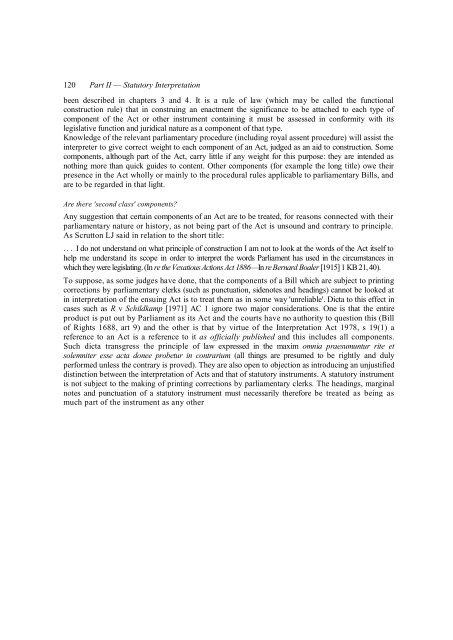Statutory Interpretation The Technique of Statutory ... - Francis Bennion
Statutory Interpretation The Technique of Statutory ... - Francis Bennion
Statutory Interpretation The Technique of Statutory ... - Francis Bennion
Create successful ePaper yourself
Turn your PDF publications into a flip-book with our unique Google optimized e-Paper software.
120 Part II — <strong>Statutory</strong> <strong>Interpretation</strong><br />
been described in chapters 3 and 4. It is a rule <strong>of</strong> law (which may be called the functional<br />
construction rule) that in construing an enactment the significance to be attached to each type <strong>of</strong><br />
component <strong>of</strong> the Act or other instrument containing it must be assessed in conformity with its<br />
legislative function and juridical nature as a component <strong>of</strong> that type.<br />
Knowledge <strong>of</strong> the relevant parliamentary procedure (including royal assent procedure) will assist the<br />
interpreter to give correct weight to each component <strong>of</strong> an Act, judged as an aid to construction. Some<br />
components, although part <strong>of</strong> the Act, carry little if any weight for this purpose: they are intended as<br />
nothing more than quick guides to content. Other components (for example the long title) owe their<br />
presence in the Act wholly or mainly to the procedural rules applicable to parliamentary Bills, and<br />
are to be regarded in that light.<br />
Are there 'second class' components?<br />
Any suggestion that certain components <strong>of</strong> an Act are to be treated, for reasons connected with their<br />
parliamentary nature or history, as not being part <strong>of</strong> the Act is unsound and contrary to principle.<br />
As Scrutton LJ said in relation to the short title:<br />
... I do not understand on what principle <strong>of</strong> construction I am not to look at the words <strong>of</strong> the Act itself to<br />
help me understand its scope in order to interpret the words Parliament has used in the circumstances in<br />
which they were legislating. (In re the Vexatious Actions Act 1886—In re Bernard Boaler [1915] 1 KB 21, 40).<br />
To suppose, as some judges have done, that the components <strong>of</strong> a Bill which are subject to printing<br />
corrections by parliamentary clerks (such as punctuation, sidenotes and headings) cannot be looked at<br />
in interpretation <strong>of</strong> the ensuing Act is to treat them as in some way 'unreliable'. Dicta to this effect in<br />
cases such as R v Schildkamp [1971] AC 1 ignore two major considerations. One is that the entire<br />
product is put out by Parliament as its Act and the courts have no authority to question this (Bill<br />
<strong>of</strong> Rights 1688, art 9) and the other is that by virtue <strong>of</strong> the <strong>Interpretation</strong> Act 1978, s 19(1) a<br />
reference to an Act is a reference to it as <strong>of</strong>ficially published and this includes all components.<br />
Such dicta transgress the principle <strong>of</strong> law expressed in the maxim omnia praesumuntur rite et<br />
solemniter esse acta donee probetur in contrarium (all things are presumed to be rightly and duly<br />
performed unless the contrary is proved). <strong>The</strong>y are also open to objection as introducing an unjustified<br />
distinction between the interpretation <strong>of</strong> Acts and that <strong>of</strong> statutory instruments. A statutory instrument<br />
is not subject to the making <strong>of</strong> printing corrections by parliamentary clerks. <strong>The</strong> headings, marginal<br />
notes and punctuation <strong>of</strong> a statutory instrument must necessarily therefore be treated as being as<br />
much part <strong>of</strong> the instrument as any other

















